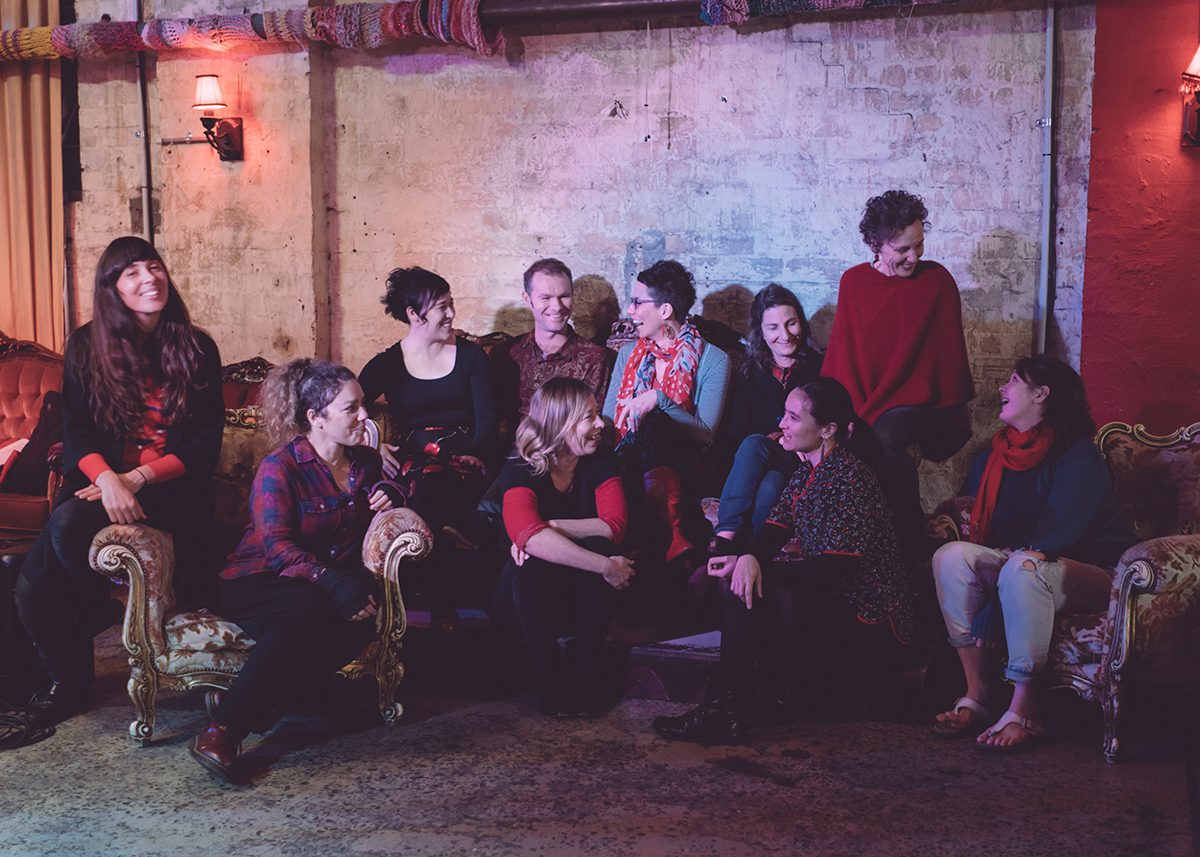Reveries and dreamlike game-playing populated Ensemble Offspring’s Who Dreamed It?, a concert of five fascinating, formula-bending works by female composers. Three of the compositions were inherently theatrical, ensemble members engagingly meeting the demands with their usual casual aplomb, while the other two works were immersively contemplative.
Irish composer Jennifer Walshe’s contribution to the program, titled Everything you own has been taken to a depot somewhere, features flautist Lamorna Nightingale and percussionist Claire Edwardes glitteringly costumed in contrast with clarinettist Jason Noble attired for baseball. The work mysteriously progresses through a series of states in which the performers exercise their arms, variously gesture, speak or sing chorally in short bursts, as in part two, titled “Views On Computerwork Romance” in which, stretching vowels, they deliver the text “OK /Bye/Who.” Elsewhere, cards with words are held aloft while Noble signals, lines from a movie are performed, bubbles blown and, finally, any sense of cohesiveness dissolves, bringing home, if lightly, the sense of loss and delirium prefigured in the work’s title — although the name of the last piece, “His seizures stopped when he started collecting rocks,” is reassuring. I couldn’t possibly deliver a cogent interpretation for this calculatedly discombobulating 10-minute work, one that might have come out of Fluxus and is performed with a conviction that strengthens its evocation of a frustrating dream state. Walshe, a composer-cum-performance artist has made works for herself and others (many available on YouTube) with titles the likes of Language ruins everything, which are well worth a look.
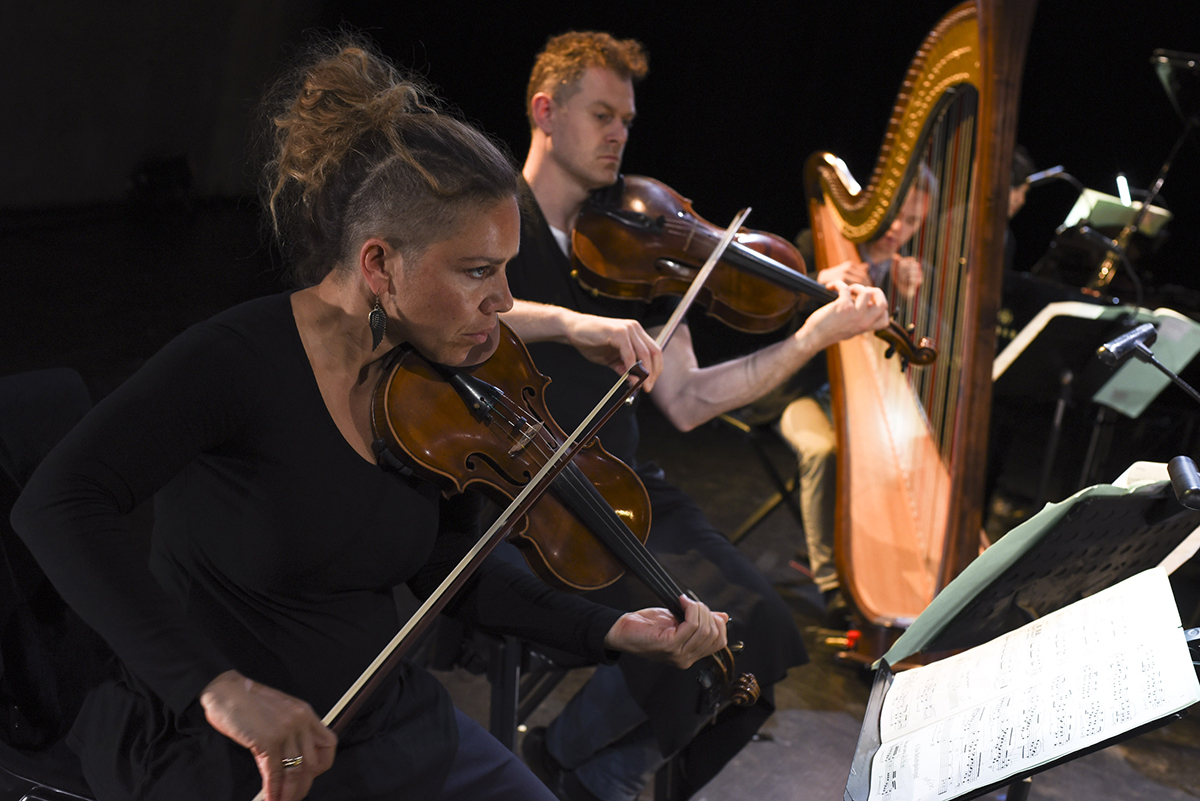
Veronique Serret, James Wannan, Who Dreamed It? Ensemble Offspring, photo Heidrun Löhr
Taiwanese composer (educated in Australia and New Zealand) Annie Hui-Hsin Hsieh’s Half-Open Beings and Australian Lisa Illean’s Cantor (After Willa Cather) proved to be quite complementary, both long-noted and suggestive of interior worlds. Over 14 minutes, Half-Open Beings, largely soft-edged and abstract, sinuously weaves its way to a rush of vibes, cowbell, high-calling clarinet and, via pizzicato strings and plucked double bass, dips back into a soft musing. I’d need another hearing to grasp its totality, but it stays with me like a half-glimpsed modernist painting.
Illean’s 13-minute Cantor is also ethereal, but warmer, romantic even, in its evocation of twilight via words from three poems by American poet Willa Cather, gloriously sung by Jessica Aszodi entirely at one with a large instrumental ensemble. Vowels are sensually extended, the voice glides up from mezzo depths to moments of passion and down, in the end, to lingering sadness. It’s a memorable work, not least for the “infusion” (as Illean calls it and reflecting the call-and-response cantor-led choral singing that inspired her) of sounds between instruments and between instruments and voice. I was surprised that I could barely detect the audio file of folk song, commentary and radio broadcast Illean had told me about when I interviewed her. I heard nothing other than a rustling and another distant soprano voice. Perhaps the ABC recording of the concert will reveal more; I wasn’t sure if I’d experienced the work in its totality.
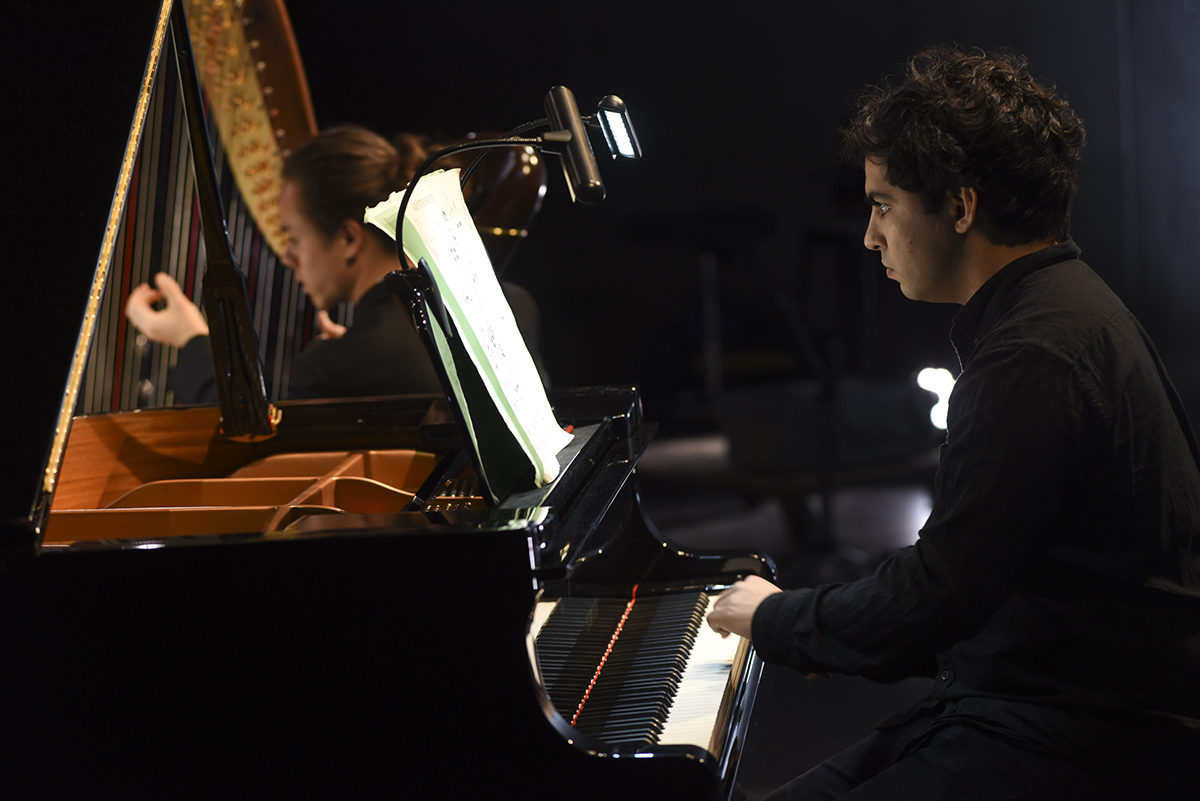
Zubin Kanga, Who Dreamed It? Ensemble Offspring, photo Heidrun Löhr
Incipio, Bibo for soprano, clarinet and percussion by US-based Iranian composer Anahita Abbasi — performed between Half-Open Beings and Cantor — was another work for trio: Edwardes, Noble and Aszodi, each additionally equipped with a small bell with which they rang for tea, in the spirit of Lewis Carroll’s Alice books which had inspired the composer and provided the work’s text. Aszodi exuded child-like excitement in tightly scored, witty vocal and instrumental exchanges that climaxed existentially with Alice’s “Who in the world am I?”
Berlin-based Korean composer Unsuk Chin’s Akrostichon-Wortspiel (Acrostic Wordplay) shared the playfulness of the works by Walshe and Anahita Abbasi, and like Illean and Abbasi’s provided Aszodi with wonderful challenges, here not only with nonsense words (“a tool for singing,” and largely minus consonants, says Chin) but also with demanding flights across registers and styles of utterance — snarky, aggressive and supremely high-flying soprano. The large ensemble provided multiple contexts — ripplings running from harp to piano, mandolin and percussion; fabulous outbursts and deep song glides akin to falling into Abbasi-Carroll’s rabbit hole; and rapid rustlings in an eerie night-time soundscape (to Aszodi’s half-whispering). The wonderfully romantic 5th movement comprises a repeated sung motif descending in steps and taken up by the harp and others, the long notes drawn out by bowed vibraphone. In “A Game of Chance,” a rattled-off alphabet seemingly evoked a child learning with gritty gusto, while the final wild movement brought with it a voice rising from the depths, a trumpeting clarinet and a surging ensemble.
The 16-minute Akrostichon-Wortspiel — full of play and reverie — was an apt finale for an embracingly cogent concert, one too that premiered commissioned works from Abbasi, Hui-Hsin Hsieh and Illean. Ensemble Offspring performed superbly, playing the game with Aszodi with observable watchfulness between members, whether as a trio or, wonderful to witness, a sizeable team admirably coached by Roland Peelman.
Read a RealTime interview with composer Lisa Illean.
–
Carriageworks & Ensemble Offspring, Who Dreamed It?, soprano Jessica Aszodi, conductor, Roland Peelman, violin Veronique Serret, viola James Wannan, cello Blair Harris, double bass Kirsty McCahon, mandolin Michael Hooper, percussion Claire Edwardes, clarinet Jason Noble, piano Zubin Kanga, flute Lamorna Nightingale, oboe Ngaire de Korte, harp Rowan Phemister; Carriageworks, Sydney, 23 Sept
Top image credit: Who Dreamed It?, Ensemble Offspring, Carriageworks, image Zan Wimberley
Although tales are sparely told in Hilary Bell’s poems-cum-lyrics, Ensemble Offspring’s Seven Stories is not a venture into literal storytelling. Each layer of this multimedia concert — instrumental, vocal, poetic and projected — is impressionistic and synched, to varying degrees (or not), with the others. Bell’s fairytales are tautly imagistic, the video metaphorical rather than narratively illustrative, the singing frequently wordless and the scoring, for all of its occasional brilliance, has on first hearing a certain minimalist sameness and aetherial waft.
The notion propounded by Christopher Brooker in The Seven Basic Plots: Why We Tell Stories (2004) that there are only seven story types is contestable, and certainly inadequate for dealing with many creation myths, especially non-Western ones. Good to see, then, Caitlin Yeo’s “Quest” commence with golden egg shakers in the prelude to a musical journey from restlessness to resolution, soprano Jane Sheldon soaring wordlessly. She speaks Bell’s quest story, which is completed in “Transformation,” the last work in the program. On a large screen suspended above the performers, a young (uncredited) woman, robed, almost on all fours, rises in Sarah-Jane Woulahan’s video to dance before a huge Sun and Moon, her body swirling and multiplying. She spins before a roiling rainbow-tinted ocean and a massive eclipse before returning to the ground, earthed, I guess. Woulahan’s video has a life of its own, suggesting inner turmoil and aspiration envisaged on a cosmological scale.
Jodi Phillis’s “Overcoming The Darkness” opens jauntily, colour-saturated flowers bursting open on the screen and Sheldon vocalising joy until a vast green forest is spookily rendered in negative, the music grim and a close-up revealing the girl’s feet pushing forward, we imagine with purpose. The music sweetens, there is new green, the screen fills with spores in flight and mushrooms sprouting fulsomely. Bell’s relatively long poem slips in and out of aural and melodic grasp. Her words are not surtitled and the high soprano singing sometimes elides consonants. I follow the poem in the dark of the auditorium and find that, at its end, music, video and text share a corresponding sense of release.
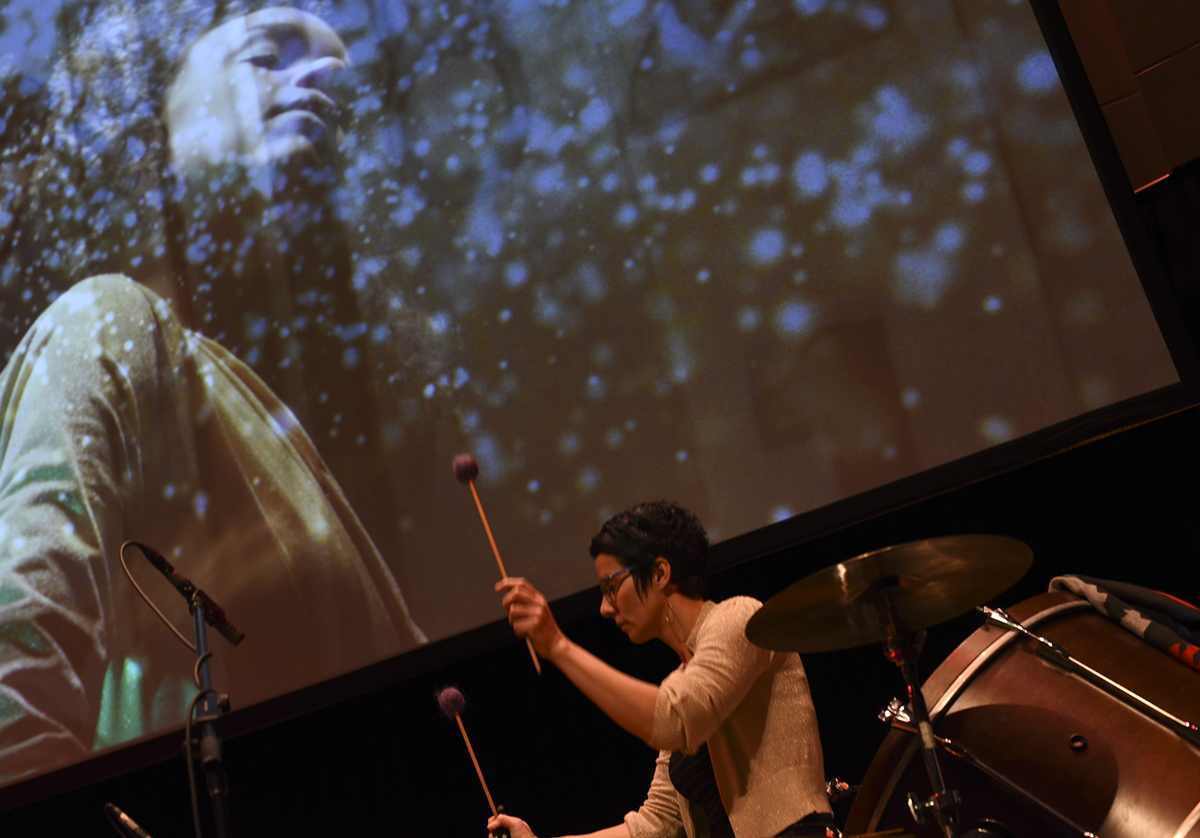
Claire Edwardes, Ensemble Offspring, photo Heidrun Löhr
The visual imagery for Amanda Brown’s “Rags To Riches” is built around the cold inevitability of time passing: there are clocks antique and elderly digital, the woman swaying in snow. The mood darkens via marimba and glockenspiel and accelerates into an aggressive Reichian dance, ocean waves tumbling, bass clarinet roaring until soprano notes float over a soft, faltering piano, incidentally apt for the poem’s ending in which riches come at another’s expense: “As for the woman hiding beneath them /Her black hair matted, her white teeth worn down /She would be cast back into the sea.” The lines recall those of “Quest” — “Each year would rob her/ Of her black hair /White teeth /Power.”
Sally Whitwell’s “Fatal Flaw” is focused, she writes in her program note, on “the inexorable,” and it is fully felt. In the poem, a mother’s pride enrages a childless goddess who locks the woman in a case, tosses her into the sea and murders her children. We see a vast red landscape, a snowbound forest, a heaving ocean viewed through a ship’s window, a cyclone, a collapsing bridge and a distant NASA view of the Earth. The clarinet is shrill, violin forceful, drumming emphatic, but out of a sense of overbearing danger emerges a fully formed, plangent song — from the cello —before a return to anxiety. A seismograph shudders, an iceberg breaks up, the lone young woman lost amid images, Jason Noble on his feet, his bass clarinet at its most powerful. Sheldon vocalises, lava pours. It’s visual overkill, but sounds wonderful, the melody memorable, the score deeply textured.
In a sudden departure from the norm, we leave Woulahan’s video world for Bree Van Reyk’s “Comedy Of Errors.” There is no young woman, no buffeting cosmos. Sheldon turns conductor for a work, its parts detailed on the screen: “Repetiton, Interruption, Overstatement” etc. Page-turning becomes hyper-emphatic, the whole ensemble whistles with the clarinettist who then, refusing to obey the conductor, hangs onto a breathtakingly long note. The second section evokes slapstick, the ensemble awash with honking horns and an inconclusive knock-knock joke. The third section is a brilliantly persuasive Miniature Double Concerto for Woodblocks executed by Claire Edwardes with Sheldon in reserve for the odd knock-on. “Comedy Of Errors” functions as a kind of entr’acte, a relief from the gloom and high drama of the initial pieces. But the absence of the video subject is unsettling; no restorative release for her of the kind comedy offers.
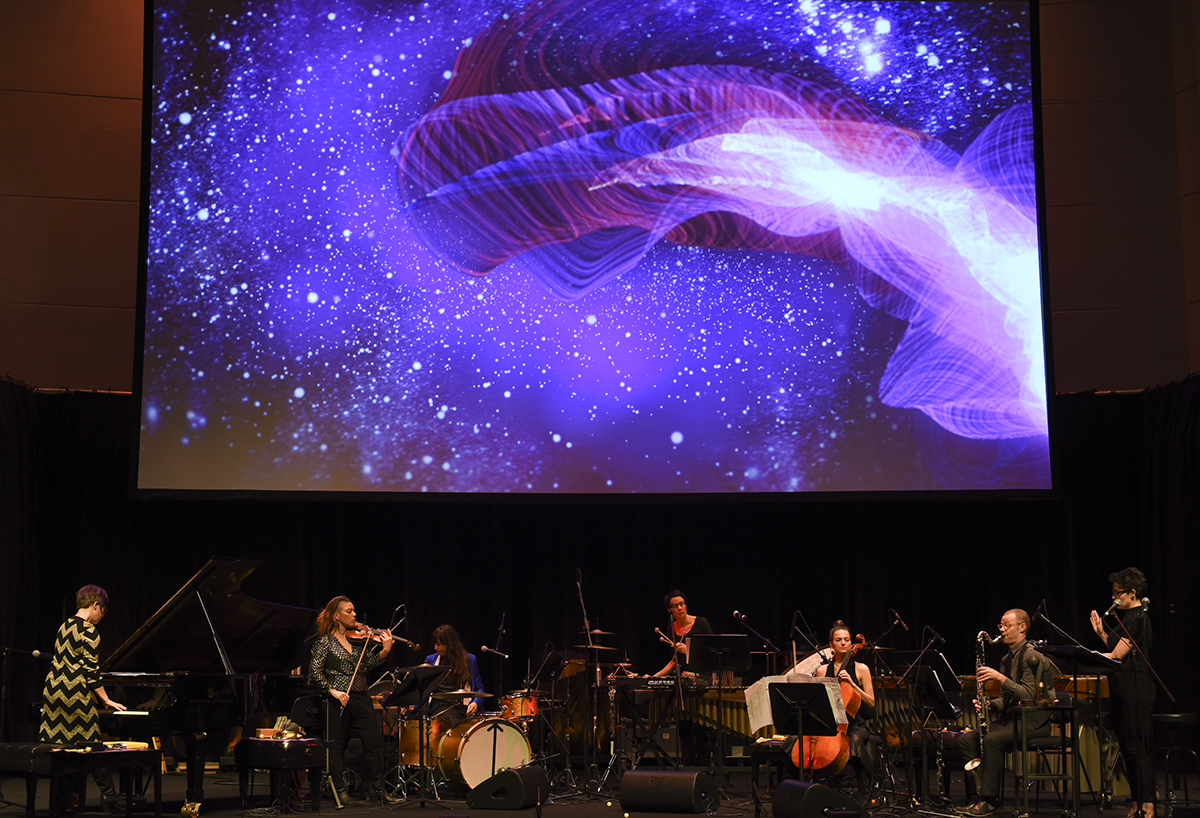
Seven Stories, Ensemble Offspring, photo Heidrun Löhr
Kyls Burtland’s propulsive “Journey” is paired with Bell’s sketch of a woman warrior who helps a pauper, leaving herself without money, so she and her horse set off to trick a giant out of his gold. On the screen, the Sun looms, railway tracks course by, the ensemble rumbles with dense minimalist intensity, lightning branches across the sky. The girl merges with the cosmos.
For her own piece, “Transformation,” Jane Sheldon writes that she “tried to achieve a sense of ecstatic suspension.” The woman in Bell’s poem having found the lover lost in “Quest,” “his hands bound in seaweed,” cannot embrace him and turns into a golden-scaled fish. The oceanic “expansive, seemingly uniform space quivering with quiet activity and possibility” that Sheldon generates laterally corresponds with the screen image in which rare close-ups of the young woman, suspended horizontally, reveal hands gently shaking, then feet and head as dazzling balls of light hover over and move through her, or as the poem has it: “her entire body gleamed with golden scales /catching the light every time she flicked her tail.” Refracted light drifts by like swathes of gathered silk and singer and ensemble quiver with shimmering rustlings and enduring vibrations. And again, the young woman achieves transcendence.
For all its many pleasures Seven Stories was not altogether satisfying: too much reliance on wordless singing instead of sufficiently committing to Bell’s poems, a critical absence of surtitles, and video art that was at times hyperbolic and its images and dancing sometimes generic. Sally Whitwell’s “Fatal Flaw” proved to be the most compelling of the works; the others certainly warranted further hearings (I’m looking forward to the ABC radio broadcast). Bree Van Reyk’s “Comedy of Errors,” if disengaged with the video layer of Seven Stories, wickedly broke through its otherwise sombre mood and Ensemble Offspring played with their usual commitment, flair and easy sense of theatricality.
–
City Recital Hall, Ensemble Offspring & Creative Music Fund, Seven Stories, composers Amanda Brown, Kyls Burtland, Jodi Phillis, Bree van Reyk, Jane Sheldon, Sally Whitwell, Caitlin Yeo, visuals Sarah-Jane Woulahan, text Hilary Bell; Ensemble Offspring: percussion Claire Edwardes, Bree van Reyk, clarinet Jason Noble, piano Sally Whitwell, violin Veronique Serret, soprano Jane Sheldon, cello Freya Schack-Arnott; City Recital Hall, Sydney, 3 June
Top image credit: Jane Sheldon, Seven Stories, photo Heidrun Löhr
Ever committed to adventurous playing and commissioning of new music, Sydney’s Ensemble Offspring has also enlarged the scope of chamber music performance, engaging over the years with experimental film, opera, cutting edge pop and dance and installation. Now the ensemble has teamed with seven composers (Amanda Brown, Kyls Burtland, Jodi Phillis, Bree van Reyk, Jane Sheldon, Sally Whitwell, Caitlin Yeo), video artist Sarah-Jane Woulahan and writer Hilary Bell to venture into the making of a collaborative world governed by seven fundamental stories, but ones told from a distinctly female perspective.
The story types, contentiously delineated by Christopher Booker in The Seven Basic Plots: Why We Tell Stories (2004), comprise The Quest, Overcoming the Darkness (sometimes a monster), Rags to Riches, Fatal Flaw (or Tragedy), Comedy of Errors, Journey and Transformation (sometimes described as rebirth). I spoke by phone with Claire Edwardes, Artistic Director of Ensemble Offspring and director of Seven Stories about the making of an ambitious, highly collaborative multimedia event.
Where did the idea come from for creating a concert driven by seven fundamental stories?
Ensemble Offspring was approached by Jodi Phillis of The Clouds and Amanda Brown of the Go-Betweens. They’d wanted to collaborate with five of their musical colleagues. And we all took it from there.
Given the nature of the concert, which involves composers, musicians, a writer and a filmmaker, was there a creative development stage?
Many. In musical terms, we went through a lot more creative development than usual. Usually, the writer writes the words and the composers go off and compose and then maybe, if you are lucky, the video comes after that, kind of reacting to the music. But often, the video is made simultaneously and, as you probably know, videos don’t always synch up and are not always completely related to the music.
But in this case, we had several creative developments with the writer Hilary Bell and the video artist Sarah-Jane Woulahan who were always in the room. Hilary especially was constantly reacting to changes we made in the music, adjusting her text and reacting to feedback from the composers and musicians. Likewise, the composers would keep revising their music based on the musicians’ feedback. So it was like a total everyway stream of feedback. I’ve never really been involved in something so open and fluid in terms of the way this project was developed.
And you enjoyed it?
To be honest, it’s a more challenging mode of working for the creatives because we, the performers, are very direct in our feedback. But it’s also hugely rewarding because it became obvious very quickly that it was all in the name of honing the best possible musical outcome and that was self evident in the final works which are simply stunning!
How is the text delivered in the performance?
Sometimes the words appear on the screen with the music or like a silent film still. At other times, they’re spoken or incorporated into the songs. The text is not a narrative that runs through the whole concert—each of the stories is quite separate—but there is the poeticism of Hilary’s words.
Jane Sheldon doesn’t sing a song in every piece; her role is sometimes as narrator and sometimes as singer. For example, in Bree Van Reyk’s piece, Jane’s a conductor/woodblock-player understudy. That’s what Bree has called her. Of the seven story types Bree got Comedy and so she went for slapstick. We have to laugh and do wolf whistles. One of the movements is a woodblock concerto for me, which is hilarious, and she’s got Jane as my understudy.
Tell me about the compositions.
Jodi and Amanda are from two quite famous rock bands in the 80s, The Clouds and The Go-Betweens, so as you can imagine their starting point musically is quite different from the composers with whom we usually work, who are generally classically trained. Many of the Seven Stories team hadn’t previously notated detailed music for live instrumentalists before so the process was a new learning curve for them. But it worked out nicely in terms of musical and aesthetic balance. Then we have Sally Whitwell who is a trained classical musician and writes very accessible songs. Kyls Burtland and Caitlin Yeo write a lot of screen music and for television.
For an Ensemble Offspring concert, the scores are quite tonal. And then Jane Sheldon is writing for the first time. Her piece ends the whole show. It’s called “Transformation” and it’s an exquisite piece working on tone-colour variation, which I think is a really great way to end the concert given we’ve had simple, touching songs and then Jane’s takes you up into the aether, sonically speaking.
The compositions might be simpler ones than you usually play but were there challenges for the ensemble?
Yes. I guess this was the whole point of the creative development. We really wanted to work with these composers to make the instrumental parts so we’re all really using our skills. We’re really multi-tasking to the max. There’s a huge percussion set-up. It’s definitely not simple for us to perform this show. It’s just that tonally it’s very melodic, very beautiful and I guess that often Ensemble Offspring concerts push boundaries. This is pushing boundaries in different ways and we hope that lots of people will like it.
Did Hilary Bell’s text emerge from the creative development to-and-froing as well?
It was very much part of it. She came to the rehearsals, wrote text, sent it to the composers and myself—as the director—and then we’d all feed back and then she’d do another draft. A few months would pass and then she’d send it to us again; we’d reflect, listen to the music and then she’d do another draft. She really changed her text based on everyone’s feedback. She’s been so open to that. It’s been wonderful working with her. No ego there! She’s amazing.
The seven stories, are these micro-stories?
Sort of, but it’s slightly more esoteric than that. There are references to fairy tales without each story being a complete narrative. It’s a more suggestive approach, referencing what people remember from their childhoods and throughout their lives and that we know these kinds of stories. Hilary hasn’t been too obvious, which I think is really nice.
How seriously did the collaborators take themes like “the quest” and “overcoming darkness?”
Very seriously. They spent a lot of time reflecting on them. The interesting thing about Hilary is that she responded to the composers and their interpretation of the story rather than the other way around.
The video trailer for Seven Stories is very dramatic: roiling waves, turbulent clouds and a young woman foregrounded before them. Tell me about the video.
I gave Sarah-Jane a brief that it would never be obvious who this protagonist is or what her story was. She’s more like a person returning in each of the stories. A number of them are linked to the sea and natural elements. There are mermaids with silver tails and so on in stories and all of that is very much picked up in the video.
Christopher Booker’s book The Seven Basic Plots, which drew on the works of Carl Jung and Joseph Campbell, has been very influential, but it has been roundly criticised for being a masculine theory. Is Seven Stories an antidote in some ways?
Yes, we realized there was this guy who was maybe not the most supportive of women [LAUGHS]. So we’ve remade them and taken them in a more feminine direction. It’s absolutely not a feminist work; more like a female take if you will on these ‘universal’ stories.
Watch a preview of Seven Stories below:
–
VIVID Sydney: City Recital Hall, Ensemble Offspring and Creative Music Fund, Seven Stories, composers Amanda Brown, Kyls Burtland, Jodi Phillis, Bree van Reyk, Jane Sheldon, Sally Whitwell, Caitlin Yeo, visuals Sarah-Jane Woulahan, text Hilary Bell; City Recital Hall, Sydney, 3 June
Top image credit: Seven Stories, Bree Van Reyck, Ensemble Offspring, photo courtesy City Recital Hall
Soundcapsule was a bi-monthly online feature offering free downloads of music by artists we had recently covered in RealTime.
All tracks are copyright the artists.
Original page on the archival site.
ensemble offspring, professor bad trip lesson 3 by fausto romitelli
Composer: Fausto Romitelli
Performers: Ensemble Offspring [cond. Roland Peelman]
Details: Recorded live at Carriageworks, Sydney, 18th June 2011
http://ensembleoffspring.com/
© the artists
Ensemble Offspring is a new music group performing works ranging from the 20th century masters to new commissions. They formed 15 years ago, originally under the name Spring Ensemble, the resident company for Roger Woodward’s Sydney Spring Festival. The group is led by percussionist Claire Edwardes and composer Damien Ricketson and has a core of regular musicians presenting an ambitious and plentiful program each year. They are well known for their eclectic approach to programming often collaborating across artforms, for example with contemporary performance group Theatre Kantanka (Sounds Absurd, 2010 and Bargain Garden, 2011), glass artist Elaine Miles (Fractured Again, 2010), scratch cinema expert and filmmaker Louise Curham (Waiting to turn into puzzles, 2008), video artists Andrew Wholly (Fractured Again) and Sean Bacon (Professor Bad Trip, 2011), and a host of specialist musicians including Halcyon vocal ensemble, improviser Jim Denley, experimental guitarist Oren Ambarchi, and electronica/noise artist Pimmon.
The track provided here is from their 2011 concert, Professor Bad Trip, highlighting the work of Italian composer Fausto Romitelli. Romitelli was inspired by the comic artist Gianluca Lerici aka Professor Bad Trip and poet Henri Michaux who both explored the effects of drug-induced hallucinations through their work (see our review in RT104).
See also realtime tv’s video interview with Claire Edwardes and Damien Ricketson
related articles
on the tightrope of audience judgment
matthew lorenzon: ensemble offspring, new radicals
RealTime issue #110 Aug-Sept 2012 pg. 48
contagious matter, infectious stuff
caroline wake: theatre kantanka with ensemble offspring, bargain garden
RealTime issue #107 Feb-March 2012 pg. 36
tripping joy time
felicity clark: ensemble offspring, professor bad trip
RealTime issue #104 Aug-Sept 2011 pg. 47
composed spontaneity
greg hooper: stockhausen: a message from sirius
RealTime issue #91 June-July 2009 pg. 50
between contemplation and delirium
keith gallasch: ensemble offspring & louise curham
RealTime issue #86 Aug-Sept 2008 pg. web
thembi soddell, artefact performance (excerpt, 2009)
http://cajid.com/thembi/
© the artist
Thembi Soddell is a Melbourne based sound artist and electroacoustic composer working across recording, installation and live performance often collaborating with cellist Anthea Caddy. She is renowned for working with dramatic dynamics that have a disturbingly visceral effect on the listener. Gail Priest described her performance at High Reflections in RT103: “Soddell, hidden from view, created an amazingly evocative soundscape of unspecified but terrifying dread coming towards us slowly from a distance. An intensifying rumble augmented by half-human, half-animal shrieks reaches its zenith and then sucks back down, vacuum-like, to a ringing almost-silence, only to begin again. With a fine balance between augmented field recording and machine noise Soddell perfectly controls this exhilarating journey into her unconscious—or is it our own?”
Her installation Window (2008) has recently been presented as part of Sound Full in Dunedin, described by Sally Ann McIntyre as “somewhat paradoxically leav[ing] its closeted participants in a state of heightened vulnerability and bodily awareness.” (Sept 5 e-dition)
related articles
the sound already present
sally ann mcintyre: sound full, dunedin public art gallery
RealTime issue #110 Aug-Sept 2012 pg. web
part 1: sydney scenes & sounds
gail priest: silent hour, ladyz in noyz, high reflections
RealTime issue #103 June-July 2011 pg. 40
liquid architecture 6: celebrating sound
gail priest
RealTime issue #68 Aug-Sept 2005 pg. 49
education feature: circuitous journeys
gail priest
RealTime issue #62 Aug-Sept 2004 pg. 34
scan 2003: thembi soddell
jonathan marshall
RealTime issue #57 Oct-Nov 2003 pg. 37
lawrence english, coprinus comatus
From For / Not for Cage (Line 058, release Sept 18, 2012)
www.lineimprint.com
http://lawrenceenglish.com/
© the artist
Lawrence English is a Brisbane-based composer, media artist and curator. He is perhaps best known for his label and mulitarts organisation Room40 which has released CDs by a remarkable number of artists, both local and international. He has also presented a vast number of concerts, series and festivals in Brisbane such as MONO, Syncretism and the Open Frame festival. English is also the Brisbane-based director of Liquid Architecture and for the 2012 incarnation, he joined with Philip Samartzis to curate the whole festival focusing on the Antarctic. Of his performance with his trio Monolith (with Werner Dafeldeker and video artist Scott Morrison) Greg Hooper wrote in RT110: “Floes crackle, ice drips, trickles plop and burble. Thin overlays of surface water, wind blown ripples, soft unbreaking waves. Fade out. …One of the best Liquid Architectures I’ve been to (but do I always think that?) and, with Monolith, an exceptional performance that deserves much greater exposure.”
English also recently collaborated with Scott Morrison on a reworking of John Cage’s film for solo light One11, as part of Clocked Out’s The Cage in Us celebrations at the Judith Wright Centre. Drawing on this material and extending it further, English has release a new album through the Line imprint, For / Not for Cage, from which this track has been taken.
related articles
antarctic reveries
greg hooper: liquid architecture 13, brisbane
RealTime issue #110 Aug-Sept 2012 pg. 18
listening anew to john cage
greg hooper, the cage in us, presented by clocked out
RealTime issue #109 June-July 2012 pg. 35
10 years of room40: privileging the ears
danni zuvela: interview, lawrence english
RealTime issue #97 June-July 2010 pg. 39
next wave: warping dreamscapes
simon sellars: lawrence english, melatonin
RealTime issue #62 Aug-Sept 2004 pg. web
earbash reviews
lawrence english. ghost towns
greg hooper
lawrence english, transit
jonathan marshall
extra bonus track: eugene carchesio, circle music 4
From Euguene Carchesio, Taster’s Menu (Room40, drm417)
http://room40.org/store/carchesio_tasters_menu_digital
© the artist
Room40 have also allowed us to giveaway a track from fellow Brisbane-based composer Eugene Carchesio. While perhaps better known as a visual artist, creating complex geometric works, Carchesio has always been active as an underground musician appearing in bands such as The Deadnotes, The Lost Domain and working under pseudo-names such as DNE. Room 40 is releasing his back catalogue over the next year and currently has on offer a free taster from which this track has been selected.


